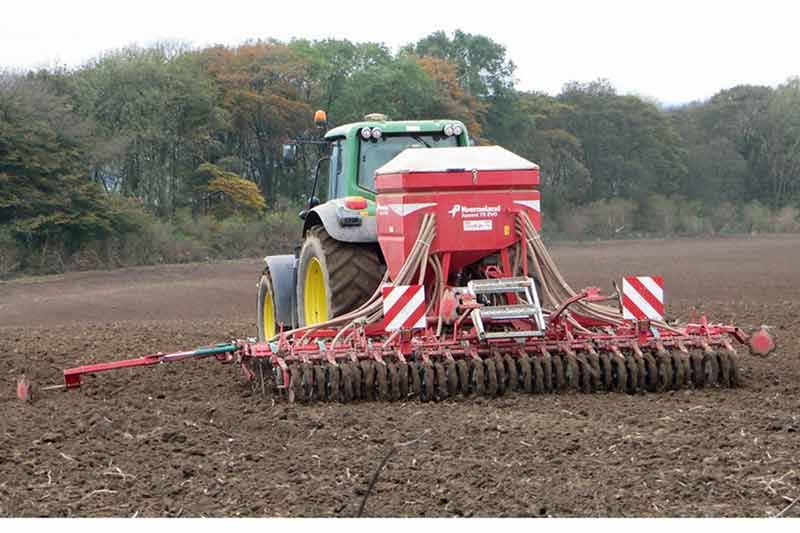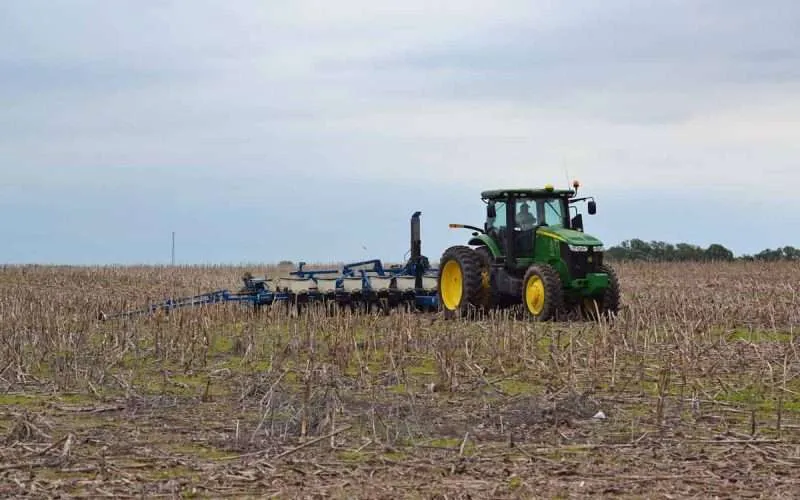Table of Contents Show
A lot of people look at plowing as the first stage of field activities, but no-till agriculture makes sure that farmers can do without that. And that too with precision.
In truth, the idea of no-till farming is even older than the orthodox one. But, the purpose of no-till methods was different in the dim past than nowadays.
In ancient times there was a lack of farming tools such as the plow and by necessity, farmers had to adopt no-till practice. Currently, the benefits of the no-till method and its advantages for nature are the main incentives. So, because it is good for the environment, this method of cultivation has found acceptance.
No-Till Agriculture Practices
No-till farming methods mean nil or the smallest amount of soil disturbance. With normal plowing, the plow turns over the top layer before planting seeds. Firstly, the tillage helps in soil aeration. Secondly, it adds in fertilizers and manure. Thirdly, it loosens the earth for coming delicate seedling roots. Fourthly, it terminates pests and gets rid of weeds.
However, this plowing method causes soil erosion. Also, it removes the cover matter and causes an imbalance in the microbe community. It also adds soil carbon into the atmosphere. Thus, it helps to increase the greenhouse effect.
So what is no-till farming then? What practices does it adopt to plant seeds, without disturbing the soil balance?
Let us explore the practices that make up the main methods of the concept.
No-Till or Minimal Tillage

No-till process of farming needs special tools (agriculture drills or disc seeders) to create furrows. The process has to plant seeds, stabilize them, and cover them at the same time. There is no double-passing the ground after plowing.
This way, the soil suffers the smallest amount of possible disturbance. The method plows exactly where the farmer wants to place the seed. What’s more, planters spend the least fertilizer, applying them right into the furrow with the help of designated tubes. And, fertilizer saved is money in hand!
Sometimes, it takes the form of a minor or narrow tilling between seasons. Farmers do this when manure created by high yields does not compost well resulting in diseases and affecting plant growth.
An alternative would be to go for lime assimilation to balance out the soil acidity.
Straw Covering
Weed control is a major affair in no-till farming as you cannot get rid of weeds by mechanical process. To resolve the issue, agriculturalists cover inter-rows with dry hay, mulches, or straw. It not only assists in subduing weeds because of an absence of light but collects moisture and shields plant roots from the sweltering sun.
Crop Rotation
Crop rotation is an effective agricultural system with many advantages. As a no-till technique of farming, it helps in the following matters:
- Weed growth and pest attacks for different crops have different pest and weed risks. Each type of crop has a particular weed and pest threat that may not affect another crop.
- Soil erosion because alternate plants have different roots.
- Soil fertility due to the nitrogen fixation property of legumes.
Effects of No-Till Farming on Soil
The word “to-till” comes from Proto-Germanic with the simple meaning “to cultivate”, or “to plow”. The chief aim of no-till agriculture is to keep clear of cultivation with soil disturbance as a rule.
How Does No-Till Farming Help To Decrease Erosion?
No-till agriculture lessens soil erosion. Tillage enters the earth’s surface and flips it over, turning over the soil surface. Thus, the exposed soil is subject to erosion due to the loosened structure.
With the removal of the cover matter, the loosened soil undergoes fast erosion due to wind and water flow. The erosion is quicker on slopes and in steep areas.
Another concern to address is rain splash erosion because the intense rain loosens and removes soil particles with ease. The lack of soil disturbance in no-till farming eliminates the issue.
Why Is No-Till Agriculture Significant For Soil Carbon Sequestration?
No-till agriculture is important for soil carbon sequestration. Tillage moves soil carbon to the soil surface. The available carbon helps provide nutrients to plants, which is a beneficial thing.
But the free carbon reacts with oxygen in the atmosphere to make carbon dioxide. The addition of carbon dioxide to the atmosphere increases the harmful greenhouse effect. The factor of carbon sequestration that comes with no-till farming is a clear advantage.
In the latter case, carbon stays in the ground. That is why there is a close link between no-till farming and the decrease in carbon dioxide.
How Does No-Till Farming Help To Support Soil Fertility?
No-till farming encourages soil conservation and preserves its potency. Tilling affects the soil’s ecological balance and impairs the microbe population. Tilling helps in pest management but then it also destroys beneficial farm insects.
With no-till, some soil microbes in their natural environs can help soil fertility with their activities.
No till agriculture also helps in soil fertility with nitrogen fixation by legumes which is a clear benefit for the crops in crop rotation.
Advantages of No-Till Farming.
The main advantages of no-till farming include:
- Improved soil health is a proven outcome and it is beneficial for the environment.
- Savings on tillage gear to plow the whole field. The latest machines allow direct sowing on the residue-covered strips in its place. Additionally, plants can get nutrients from the disintegrated material this way.
- Restricted fossil fuel inputs for field operations. According to the U.S. Department of Agriculture, no-till can save about (3.6 gallons) of diesel per acre.
- Shorter operation time. Modern seeders do the job quicker and finish it in one field pass.
- Less manual labor is needed for tilling processes. Moreover, fewer man-hours are spent on the maintenance of tillage machines.
- Preserved moisture and reduced water use because of less evaporation and low soil cracking.
- Reduced herbicide leakage because of less recurrent irrigation.
The advantages of no-till farming have convinced many farmers to adopt this method of planting. The USDA has also helped by pointing out its ecological and economic benefits.
Some Problems of No-Till Farming
An issue of no-till farming is that in spring, the soil both warms and becomes dry more slowly, which can postpone planting. Harvest may thus take place later than in a normal tilled field.
The lag in warming occurs because crop residue is lighter in color than the soil and absorbs less solar energy. On the other hand, the uncovered soil in normal tillage would capture more solar energy. Thus it would be quick to get warm and dry. Using row cleaners on a planter can handle this problem in no-till farming.
On some crops, such as continuous no-till corn, the surface residue density may become an issue. To handle this problem, farmers should use the right equipment from planting to harvest. Moreover, proper methods of managing residue on the field can be helpful.
No-till farming involves special seeding equipment, such as heavy seed drills to enter the soil through the residue.
This means extra expenses for the farmer. But selling plows and heavy tractors can offset the expenses. No-till methods need smaller tractors. Despite this, usually farmers tend to keep their old equipment while trying the no-till methods.
If the soil has reduced drainage, it could need costly drainage tiles or added devices to get rid of surplus water under no-till. Water infiltration recovers after 5-8 years of no-till farming.
One of the reasons for tilling is to remove weeds. So it seems that there is a problem of weed infestation with no-till. With no-till farming, the weed composition undergoes a change. The natural surface vegetation prevents common weeds from growing.
The weed problem in no-till is usually addressed with a herbicide like glyphosate. The use of herbicides is not a strict need. Some other alternatives can be winter cover crops, burning, or soil solarization.
Does Organic Agriculture Use No-Till Farming?
One of the main no-till farming drawbacks is the need for more weed control. The weed control herbicides consist of industrial chemicals and that is a concern for mankind and nature.
Organic no-till farming uses integrated weed management to solve the problem. It includes non-chemical herbicides, poultry or cattle grazing, and cover crops with shearing before seed settlement. Crop rotation also helps.
Furthermore, there is a misconception that no-till agriculture uses genetically modified organisms with greater resistance to weeds and pests, which does not meet the terms of organic farming. That is not true. The idea is to select robust, and thus more resistant species, not genetically adjust them.
Managing Low Residue Level in No-Till Fields
After-harvest crop residues or cover crops have many advantages. Firstly they shield the earth from erosion. Secondly, they warm it up and dry it out in spring. Thirdly they add nutrients for the plants of the following season. Fourthly they control the weeds and function as mulch. And these are just a few of the benefits.
But, at the commencement of the sowing period, they are usually undesirable. If the residues are small, they might not need any treatment in no-till farming. But, if the area is bare or has little vegetation, it needs further covering.
High residues affect planter operations, stopping the ground from a suitable amount of drying and warming in spring. So there is a strong case for their removal.
Conventional farming manages weeds with plowing. No-till agriculture sets aside this process. It uses other residue management methods such as herbicide applications, cutting for fodder, or grazing.
A classic example of double cropping in no-till systems is when you plant winter grains, hairy vetch, or crimson clover in winter. Then, cut them before flowering to grow summer vegetables or mid-season brassicas no-till in the cover crop mulch. Other arrangements may be corn after soybeans or hay after wheat.
These no-till farming practices are productive, but they need accurate timing. If the fields are dry enough, residues should be removed one to two weeks prior. If the fields are wet, it ought to be done right before planting.
No-Till Farming around the World
People around the world are already profiting from this technique. In the dry steppes of northern Kazakhstan, farmers have adopted this method since 2013 to keep their crop yields high.
Moreover, farmers in Western Australia have adopted no-till agriculture to increase farmed land as well as crop yields. In South America, no-till is being done on 70 percent of cultivable land.
Future of No-Till Farming
This technique is here to stay though No-till farming method is not expected to bring results as early as the successive season in most cases.
Yet, as seen by examples across the planet people the effort is worth trying since people are able to gain higher yields over time. In perspective, no-till farming is feasible theory in terms of money spent versus money gained.
This is not the only benefit, though. No-till agriculture is also helpful for the environment. It helps in removing the negative effects of farming practices on the environment, climate, and earth’s general health.
These proven no-till farming benefits will inspire even more farmers in the future.




